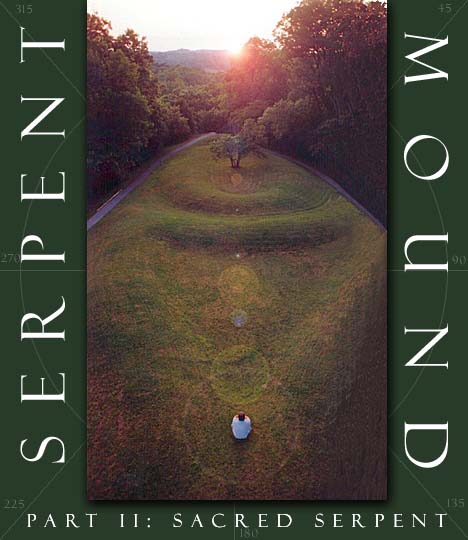
Editorial
|
Press Releases
|
Book Reviews
|
Fragments
Serpent Mound II
|
Giants II
|
Osiria II
Register
for our new Hall of Records Newsletter!
Questions? Comments? Suggestions? Advertising? Press Releases?
Contact us!
Serpent Mound Part I: Great Serpent
America's Prehistoric History
|
The Mysterious Hopewell
Sacred Astronomy
|
Sacred Serpent
|
Visiting the Serpent
Serpent Mound Links
|
Serpent Mound Books
|
Serpent Mound Audio
|
|
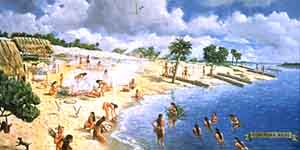
|
|
|
"Seminole Rest"
by Martin Pate. This painting depicts a prehistoric clam gathering and processing site located on the Atlantic coastline near
the border between Florida and Georgia. The
Seminoles
were descendants of the
Creek
Indians, who were in turn descendants of the
Muscogee
Indians. The Creek were part of a southeastern alliance of Native American peoples known as the Creek Confederacy, which was in turn
a part of the larger
Mississippian
moundbuilding culture that ruled the region centuries after the builders of the Serpent Mound passed into history. The ancestors of the Seminoles and
their Creek forebears the Muscogee had originally migrated from the American southwest to integrate with the polyglot of cultures that
made up the Mississippian culture, which at one time had spread from the Mississippi River to the Atlantic coast. The Seminole are thus
a good example of how America has been a diverse, dynamic cultural "melting pot" throughout its history.
Image from
Southeast Archaeological Center.
|
 merica has always been a melting pot of peoples, of cultures, most of whom have been long forgotten, or are remembered only in fragmentary oral histories, myths and legends. Many peoples have left their mark on the American landscape, but most of their specific names and histories have been lost. However, subtle clues have been left of their passing, clues that have revealed the rich tapestry of America's ancient history.
merica has always been a melting pot of peoples, of cultures, most of whom have been long forgotten, or are remembered only in fragmentary oral histories, myths and legends. Many peoples have left their mark on the American landscape, but most of their specific names and histories have been lost. However, subtle clues have been left of their passing, clues that have revealed the rich tapestry of America's ancient history.
North America's ancient history — specifically, the part that began when many believe mankind first began to migrate to the Americas roughly 12,000 years ago — has gone through several major periods. These periods have been roughly based upon the relative level of civilization and technological achievements developed by the Native Americans during each period. An understanding of this "pre-historic" history of North America is necessary to fully understand the meaning of the Serpent Mound, and the people who made it. Moreover, in the process of discovering the identity of these ancient
astronomers, geometers, and magicians
of ancient America, we may discover that man's inhabitation of North America may have been much older — and much more advanced — than most have previously thought.

America's "pre-historic" history
— at least, that part of North American history that has been accepted and promoted by mainstream academia —
can be broken into roughly four major periods: the Paleo-Indian Period (9500-7500 b.c.), the Archaic Period (7500-1000 b.c.), the Woodland Period (1000 b.c.-1400 a.d.), and the Oneota Period (1400-1600 a.d.).
The
Paleo-Indian Period,
which began at the end of the last Ice Age, is
of course the least understood, due to its extreme antiquity. These archaic ancestors of the Native Americans were believed to have migrated from Siberia to North America via the
Bering Strait.
The strait at that time was above water due to the fact that much of the water now filling our oceans was still frozen in the form of the massive glaciers that covered much of North America at that time. These ancient Native Americans essentially conquered North America, taking it away from the massive
|
|

|
|
|
A
Woolly Mammoth,
one of the megafauna that once ruled North America and much of the rest of the world during the
Pleistocene epoch.
Some believe that the mammoths were killed off by the many cataclysmic floods and similar events that characterized the end of the last
Ice Age,
and the remainder were hunted to extinction by the Paleo-Indians.
Image from
BBC - Walking with Beasts.
|
|
megafauna
such as the
woolly mammoth
that had ruled it to that time.
These nomadic hunters were known for their use of large, heavy spears to bring down their massive prey, tipped with the large spearheads commonly known today as
"Clovis points".
During the
Archaic Period,
these primitive hunter-gatherers converted from a purely nomadic lifestyle to a more settled existence, restricting themselves to a handful of communal campsites which they occupied based upon the availability of game in the region. At the end of the Archaic Period, these now-native Americans began to get more involved in agriculture and trade with other neighboring tribes, and began to develop tribal identities.
Following the Archaic Period, which ended around 1000 b.c., came the
Woodland Period.
The Woodland Period was to last over two millennia, until around 1400 a.d., depending on how one dates the beginning and end dates of the period.1 Many cultures came and went during this time, leaving precious little evidence behind them, but enough to tell us that the Native Americans during this time began to become more and more civilized. They began to plant crops, settled into regular hunting and fishing areas, and even developed extensive trade networks which, at their peak, stretched from the Atlantic Coast all the way to the Rocky Mountains. Most importantly to our present study, they began to build mounds, including effigy mounds.

|
|
|
|
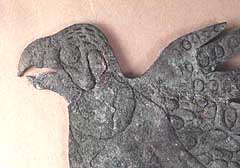
|
|
|
Copper Falcon effigy, ca. 1-350 a.d. This effigy, made of pure native copper from the northern shore of Lake Superior, was found as part of an elaborate deposit of Hopewell objects at the Mound City Group, located near Chillicothe, Ohio. Its existence indicates relatively advanced capabilities in the areas of metalsmithing and metalworking, more advanced than previously supposed.
Image from
National Park Service.
|
It was during the Woodland Period that Native American cultures achieved their pinnacle of religious, social, economic, political and, particularly, technological achievement. It also was during this period that the image of the classical Native American Indian that is familiar to Westerners began to take shape, as it was during this extended period of over two millennia that Native Americans began to develop the bow and arrow, pottery, organized agriculture, and complex religious beliefs and funereal practices, including the construction of burial mounds. In fact, archaeological evidence strongly suggests that the Native Americans of the Woodland
Period were actually more advanced than those that met Columbus, the Conquistadors, and even the Pilgrims.
The Woodland cultures are to be distinguished from the
Mississippian
cultures, which began to appear near the end of the Woodland Period, primarily in the flood plains of rivers such as the Mississippi — hence, the name "Mississippian". The Mississippian cultures were characterized by more centralized "chiefdom" social structures, organized around Temple Mound complexes such as
Aztalan
and
Cahokia, located primarily in what would become the central United States, particularly around the Mississippi River.
The Woodland Period, however, was centered primarily in the eastern United States, specifically around the area of southern Ohio and northern Kentucky.
During this period, three major woodland cultures rose and fell in what would become the eastern United States, the latter of which was contemporaneous with the rise of the Mississippians:
|
|
|
 |
|
|
Paleo-Indian Period
|
9500-7500 b.c.
|
|
|
Archaic Period
|
7500-1000 b.c.
|
|
|
Woodland Period
|
1000 b.c.-1400 a.d.
|
|
|
|
Hopewell
|
100 b.c.-500 a.d.
|
|
Fort Ancient culture
(Serpent Mound?)
|
900-1400 a.d.
(1070 a.d.?)
|
|
|
Mississippian Period
|
900-1700 a.d.
|
|
|
Oneota Period
|
1400-1600 b.c.
|
|
|
|
|
|
|
 THE ADENA CULTURE:
THE ADENA CULTURE:
The Adena were a loosely associated series of semi-tribal groups that formed a more-or-less homogeneous culture that dominated central and eastern North America for close to 1,000 years, from 1000-100 b.c. Their culture, and all of the major Woodland Period cultures that were to follow, was centered in the area that would later become known as the state of Ohio — specifically, southern Ohio. The Adena were named after the mansion of Ohio Governor Worthington, who presided over the state around 1800. The first mound that was traced to this culture was located on the governor's property, near his mansion, "Adena", and was thus called the
Adena Mound.
In the process of excavating this mound, it was found that it was filled with layer after layer of burials, some of which were laid out in wooden sepulchers that had been, at the time of burial, seven feet wide, ten feet long, and tall enough for a man to stand in. The evidence uncovered by this excavation made it clear that the Adena had made further social and technological advances than had the Archaic Period Native Americans, engaging in increasing amounts of interregional trade, agriculture, accumulation of exotic materials, and the development of complex mortuary practices involving the use of mound burials. The Adena, like their cultural descendants, the Hopewell, were centered around the region of southern Ohio and northern Kentucky, and were particularly associated with the watershed of the Ohio River between Louisville, Kentucky and Pittsburgh, Pennsylvania.2
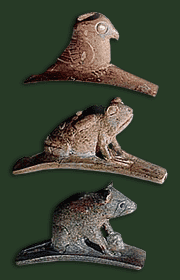 |
|
|
Hopewell artists carved ceremonial pipes into the shapes of animals. These specimens include an owl, a toad, and a raccoon.
Image from
Ohio History Central.
|
|
 THE HOPEWELL CULTURE:
THE HOPEWELL CULTURE:
The Hopewell, like the Adena before them, were a collection of loose-knit tribal groups that shared a common set of beliefs, though the Hopewell exhibited a noticeably higher level of social organization and technological advancement than had the Adena. The Hopewell peoples, though they only existed as a coherent culture for a relatively short period of time — from around 100 b.c.-500 a.d. — represented the Woodland Period peoples at their peak. Among other things, they developed the most advanced agricultural systems, and built structures that demonstrated an understanding of mathematics and astronomy that was unusually advanced. As a direct result of this advancement, moundbuilding reached its peak under the Hopewell, who left behind numerous astronomically aligned conical, linear, square and even octagonal mound structures and earthworks that demonstrated an unusual level of mathematical and astronomical precision. These mound structures also appear to have been shaped and aligned in such a way as to communicate the religious worldview of the Hopewell peoples. The remains of this prolific culture are concentrated near Chillicothe, Ohio, where a
national park
has been set aside to preserve them, though evidence of the Hopewell culture can be found scattered throughout the southeast.
 THE FORT ANCIENT CULTURE:
THE FORT ANCIENT CULTURE:
The Fort Ancient culture were a people living along the Ohio River and its tributaries in southern Ohio and northern Kentucky from approximately 900-1400 a.d. It was originally believed that the Fort Ancient Culture was part of the Mississippian culture that arose near the end of the Woodland Period, though that concept is now in dispute, some now believing that they evolved separately but concurrently from the Mississipians out of the Late Woodland cultures. The
"Fort Ancient"
people were so named due to the fact that evidence of their existence was first found within a high-walled, fort-like structure, dubbed "Fort Ancient" by the locals, off the Little Miami River in southern Ohio, near modern-day Oregonia. However, "Fort Ancient" was most likely not a
fort, but a
Hopewell ceremonial center
that the Fort Ancient people occupied and built upon, 400 years after the Hopewell had ceased to exist as a coherent culture. Another well-preserved historical location of these ancient, mysterious people is the
Earthwatch Village,
the largest and most completely excavated Fort Ancient Prehistoric Indian site in the United States.
Though the Fort Ancient peoples were more recent, archaeological evidence appears to indicate that they had inherited much of their culture from the Hopewell. The Hopewell culture was more technically advanced, particularly in the areas of astronomy, mathematics, and agriculture, but their relatively high degree of advancement appears to have become degraded by the time the people of the Fort Ancient period came upon the scene. Like the Egyptians of the Dynastic Period, it appears that the Fort Ancient people inherited the structures of their predecessors, but may not have fully understood their meaning and purpose.

|
|
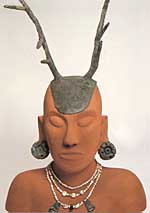
|
|
|
A reproduction of "Hopewell Man", adorned with a native-copper headpiece, earspools, and three strands of freshwater pearls embellished with copper and silver pendants. Image from
The Field Museum of Natural History.
|
|
The Native Americans of the Woodland Period enjoyed a near-ideal situation, including a stable climate, vast forests full of game, and endless fields of fertile prairie ready for planting. This extended period of relative stability in turn gave them the time and the resources to develop some fairly sophisticated religious beliefs, as well as time to study and learn more about their environment. As a result, the Middle Woodland Period was the time during which the Native Americans attained their highest level of cultural achievement, under the aegis of a culture now known to us as the Hopewell. As Romain explains,
The Hopewell
were a special people who, to a greater extent than any of the people in eastern North America who preceded them, unlocked the secrets of geometry, developed a sophisticated system of measurement, and even came to understand the great cycles of the sun and moon. These were tremendous accomplishments of the mind and spirit that have almost been forgotten, almost lost in the shadows of time.... From what we can tell, the Hopewell lived in small, scattered hamlets that surrounded their great ceremonial centers.... The Hopewell were hunters and gatherers. But they were also agriculturalists. In fact, to a greater extent than any other people in eastern North America, the Hopewell were responsible for accelerating the change from food gathering to food producing economies.... The Hopewell were farmers. But that does not mean that they were parochial or provincial. Quite the contrary. The Hopewell were wide ranging in their contacts, with a resource network that reached for hundreds of miles in all directions — north to Lake Superior, south to the Florida Gulf Coast, east to the Carolinas, and west to the Rocky Mountains. From these distant places, the Hopewell imported huge quantities of precious materials that included copper, silver,
|
|
|
|
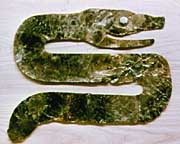
|
|
|
An Adena or Hopewell era serpent made of pure mica. Mica was one of the numerous minerals unique to the American southeast that was an
important resource for craftwork or for trade. Image from
The University of Misssouri-Kansas City.
|
mica, obsidian, quartz, and even alligator and shark teeth. The Hopewell then fashioned these materials into some of the finest examples of craftsmanship ever seen — beautiful creations that include delicate musical panpipes, effigy smoking pipes, copper breastplates, rings and bracelets, pearl-covered blankets, ornate headdresses, and other rare works of art. We know that the Hopewell were accomplished in agriculture and fine craftsmanship. Only now, though, are we beginning to appreciate the full extent of their accomplishments in other areas, such as plane geometry, measurement, arithmetic, and observational astronomy.3
The Hopewell were a relatively advanced and civilized people at the same time the Roman Empire was at its peak. Their mastery of astronomy and geometry, and of measuring and counting evidences an ability to create the sort of complex religious, social, economic and political systems that are necessary for the development of a relatively advanced and stable society. It was this relatively advanced and stable society that in turn gave them the luxury of making prolonged and detailed observations of the heavens, and to develop a complex religious worldview based upon the movements of their gods — of the sun, moon, stars and planets — in the heavens.

|
|
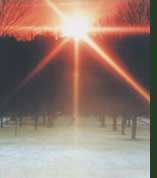
|
|
|
Winter solstice sunset in alignment with the Marietta, Ohio "Sacra Via", taken December 21, 1996. Image by William F. Romain, from
Mysteries of the Hopewell.
|
|
Ancient religion, whether in North America, South America, Africa, Asia, Australia, Europe, the ancient Near East, or anywhere else in the world, was defined by one basic concept: the worship of the material world. In the worldview of the ancients, the universe was the supreme deity, and the forces of nature were manifestations of this supreme deity, lesser gods to be worshiped as aspects of this one great god. As a result, the polytheistic religions of the ancient world ascribed the actions of the forces of nature such as the wind and the rain, the sun, moon and stars, of heaven, and of earth to individual deities, each of whom was in charge of a particular natural force. As such, by worshiping these deities of natural force, the ancients sought to integrate themselves into the natural order. And one of the primary methods they used to accomplish this integration was to build structures for living and for worship that reflected the world around them.
Like their counterparts the world over, the Hopewell sought order and meaning in the world around them. And, like their counterparts the world over, they found it through their discoveries in astronomy, geometry, measuring, and counting. Moreover, they seem to have found meaning in the underlying symbolic and metaphorical relationships between these mathematically based endeavors of the mind and the biological rhythms of life and death.... The discoveries that the Hopewell made in astronomy, geometry, measuring, and counting are reflected and incorporated in their earthworks. These earthworks, or earthen creations, in turn, helped integrate the Hopewell into their universe.4
Romain believes that the ancient Hopewell created numerous circular, square, and even octagonal earthworks and arranged them in such a manner as to reflect their "cosmology", or concept of how the universe is ordered: "Ancient peoples built their temples, shrines, and even cities to reflect, on a smaller scale, the geometric order they believed to exist in the universe at large. [They built] cosmograms — that is, buildings or architectural works that incorporate into their design a map or plan of the cosmos."5
This practice was widespread throughout the ancient world, including
Angkor Wat
in southeast Asia,
Teotihuacan
in Mexico, of course the
Pyramids
in Egypt, Stonehenge, and many, many more throughout the world, including the earthworks of North America.
According to Romain, there were three major "deities" that were preeminent in the Hopewell cosmology: the sun, the moon, and the earth. Moreover, he believes that the three major types of earthwork that the Hopewell created — square, octagonal and circular — were intended to symbolize these three great deities of their pantheon. Let us look at each of these in detail:
 THE SUN
THE SUN
Romain has concluded, based on a thorough study of Native American architecture and symbolism throughout North America, that square earthworks were meant to represent the sky — particularly, the four "corners" of the sky, what we understand as the four cardinal directions: north, south, east and west, and the four winds associated with these directions. More specifically, square earthworks were associated with the sun in the sky, and were typically oriented to the summer and winter solstice sunrises. This "square cosmology" was even reproduced in the arrangement of the living spaces of some cultures, who arranged their living quarters in a square called the "square ground", in the center of which sat the "sacred fire" that symbolized the sun.
"Important to the concept of the symbolism of the square grounds was the sacred fire. Appropriately enough, this fire was located in the middle of the square ground. Throughout the southeast, fire was considered to be an earthly representative of the sun.... The concept of a sacred fire, identified with the sun, and fed with four logs oriented to the four cardinal points, thus forming a cross is the most widespread and basic ceremonial concept in the southeast."6
In native American cosmology, the sky was the home of the great sun god, who ruled the sky and the four winds of heaven, and was thus likely the greatest god of their pantheon. Its symbology was the most uniform and widespread to be found throughout ancient America.
"The symbolic meanings of the cross, the square, and the bent-arm cross were the same for historic Indians of the Southeast, the prehistoric Mississippians, and the Hopewell: namely, symbols of the sky, the four world quarters, the four cardinal directions, and the four winds."7
 THE MOON
THE MOON
|
|
 |
|
|
The seven visible phases of the moon. The eighth phase is the "new" or completely dark moon. The Hopewell apparently were aware
of the eight basic phases of the moon, and reflected this fact in their octagonal earthworks.
|
Octagonal earthworks are part of at least two major remaining Hopewell mound complexes in the Ohio Valley: The
Newark Octagon
and the
High Bank Octagon.
What led Romain to believe that the octagonal earthworks were intended to represent the moon was the fact that both of these earthworks were aligned to 53.4° north, which perfectly matches the moon's farthest northern rising point, and also display numerous other lunar alignments. Moreover,
"It is interesting to find that the
Newark Octagon
and the High Bank Octagon are both associated with the moon by virtue of their alignments; but there is yet another association with the moon in terms of geometry. That is, because they are octagons, both ... have eight sides. This
coincides with the number of lunar phases visible to the naked eye during the course of a month. These phases are new moon, waxing crescent, first quarter, waxing gibbous, full moon, waning gibbous, last quarter, and waning crescent."8 Romain believes that the alignments with the moon may have been meant to form a magical link with the underworld, which the moon represented in their cosmology. The moon god, though perhaps less important than the sun god, also held an important part in the cosmologies of ancient America, and appears to have been associated with the world of the dead. As such, by aligning their earthworks and burial places with the moon, it may be that they believed that the souls of their dead would be shepherded by the moon to the place of the dead, safely transported by the moon god to a place beneath the nighttime horizon, where they believed lay the doorway to the underworld.
 THE EARTH
THE EARTH
Romain argues that, like the sun and the moon, the Earth was also represented symbolically in the mounds, earthworks and dwelling spaces of the ancient Americans. This too, like the sun and the moon, is based upon the belief that "the majority of Native American peoples are found to have modeled various architectural structures as symbols of the cosmos."9.
Though we have examined the roles of the sun and the moon, it is believed that at the center of ancient American cosmological beliefs sat the Earth, a sacred mound over which the sun, moon, and other gods regularly reenacted the cosmic drama. To reflect this belief, they built circular dwellings and ceremonial structures to represent Earth that were distinct from, yet aligned with the square and octagonal structures that represented the sun and the moon, respectively. Romain explains, "The large square Hopewell enclosures were meant as symbols of the sky or heavens; correspondingly, the large circular enclosures represent the Earth."10 It is interesting to note also that the octagon is a transitional form between the circle and the square, just as the moon is a transitional object between heaven and earth.
These ceremonial structures representing sun, moon, Earth, and perhaps other stars and constellations were more than mere ornaments in the minds of the ancient Hopewell. They were sacred spaces that acted as doorways to the other world, as magical means by which they could connect with the spirit world. In the minds of the Hopewell, these were sacred geometrical structures that provided a doorway to the mysterious world beyond the five senses, which they believed allowed them to transcend and control that world. As Romain explains,
"Although the magical symbols used by medieval alchemists and magicians may differ in size from the Hopewell geometric earthworks, the principle is the same. By manipulation of such symbols, the shaman or magician expects to influence or control the forces of nature or the universe. In this sense, the Hopewell geometric earthworks can be thought of as magic symbols we are more used to seeing."11
With this in mind, let us now turn to the most famous of all Woodland Period mounds, the Great Serpent Mound:

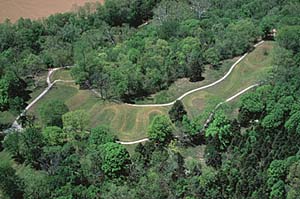
|
|
|
The origin of the Great Serpent Mound is in some dispute. It was originally assumed that the Serpent Mound was built by the Adena, due to the existence nearby Adena burials. However, others believe that it is likely Hopewell in origin, as it appears to more closely match their level of skill and predilections in its form and function. Recently, more fuel has been added to the debate with the carbon dating of some wood charcoal taken from the mound, which placed the building of the mound during the Fort Ancient period: "Two samples of wood charcoal were obtained from undisturbed parts of Serpent Mound. Both yielded a date of ca. A.D.1070, suggesting that the effigy was actually built by people of the Fort Ancient culture."12
This is not definitive proof, however, as Romain explains: "It may be that charcoal samples
recovered by Fletcher and Cameron's team were inadvertently recovered from layers of earth that were added to the effigy by
Frederick W. Putnam
of the Peabody Museum in an effort to restore the Serpent Mound to its original height".13
Putnam, a prominent archaeologist in the latter half of the nineteenth century, had been charged with surveying the mound in 1883, and was later instrumental in recovering the mound from further destruction by farming. Putnam had taken great care in restoring the mound to its original shape and height but, in the process of restoring the mound, had added dirt from nearby sources. As a result, the specimen had been tainted and, as Romain has correctly deduced, would require a more thorough testing in order to account for that variable. So, for this reason and many more, Romain remains convinced that the Serpent Mound is of Hopewell origin.
In my opinion the effigy is of Hopewell origin. This opinion is based upon several observations. First, the structure exhibits a geometric complexity that is more typical of Hopewell than either Adena or Fort Ancient. Second, there is clear evidence that the Serpent Mound builders used lesser multiples of the 1,053-foot unit of length commonly used by the Hopewell. Third, the serpent effigy incorporates various astronomical alignments, including alignments to the moon's mid-point as well as maximum and minimum rising and setting points. These lunar alignments appear to be exclusive to the Hopewell.14

In 1985, Romain embarked on a detailed physical survey of the earthwork. Through the detailed measurements that were achieved through the usage of state-of-the-art surveying equipment, he discovered numerous, clear lunar alignments and one unusual solar alignment that were very similar to alignments found in the numerous Hopewell earthworks that had previously been surveyed in the region. Like the octagonal and other mounds, the Serpent Mound displayed the same level of astronomical sophistication that only the Hopewell were capable of producing. Thus, it was logical that the Hopewell had created the Serpent Mound, as apparently only they were capable of building it.
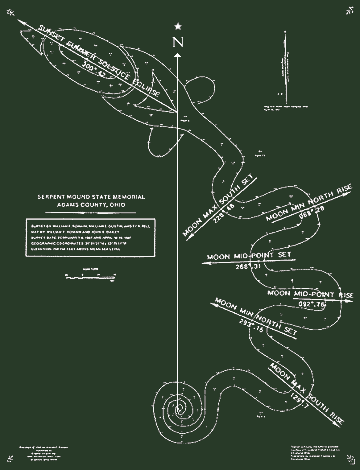
|
|
|
Lunar alignments correspond to six of the seven coils of the serpent effigy. The coils to the right point to the moon's maximum northern, southern, and central rising points, and the coils to the left point to the moons maximum northern, southern and central setting points. As such, the serpent is closely identified with the moon, and with the underworld. The head and oval also point to the sun's maximum northern setting point, during the summer solstice, and appear to show the sun symbolically being "swallowed" by the serpent. The serpent is also aligned to true north via a line traveling from the center of its coiled tail to the base of its head.
Image courtesy
Serpent Mound Mysteries.
|
|
Romain found that the three major "coils" of the serpent neatly aligned with the maximum northern, southern, and central rising points of the moon — its
"major standstills".
Moreover, he found that the coils of the serpent had been arranged with such precision that their opposites also aligned closely with the maximum northern, southern and central setting points of the moon. Such a feat requires an uncommonly high degree of astronomical skill, plus an understanding of the moon's 19-year
metonic cycle,
which had not been discovered by the Greeks until the 5th century b.c., a mere 400 years before the time of the Hopewell. Also, the head and oval embankment point toward the sun's northernmost setting point, at the summer solstice, and the monument as a whole appears to be oriented to true north, via a line drawn from the center of its coiled tail to the base of its horned skull. Romain summarizes his discovery thusly: "In summary, these data show that eight astronomical alignments are found in the Serpent Mound. The most accurate alignment is to true north, while the next most certain alignment is through the oval embankment to the summer solstice sunset. Six lunar alignments were also found."15

|
|
|
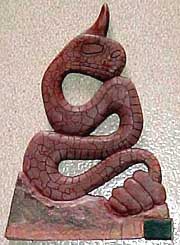
|
|
|
A Cherokee stone carving of the ledgendary Great Horned Serpent known as "Uktena." The Great Serpent Mound also once had projections on either side of its head which some believe were intended to represent horns.
Image courtesy
Serpent Mound Mysteries.
|
|
The Great Serpent Mound, then, was closely associated with the moon in the minds of the ancient Hopewell, its manifold curves clearly delineating the moon's habitual haunts in the night sky. As such, it clearly fits in with the Hopewell's obsession with sacred geometry, astronomy, and architecture. Yet, some questions remain. Why choose the form of a serpent to symbolize the underworld? And why is the serpent shown apparently swallowing the sun? Romain believes that the serpent may be representative of the "Great Horned Serpent of the Underworld" of Native American myth and legend, which also attacks and swallows the sun.16
The Serpent Mound represents the struggle between the Great Horned Serpent of the underworld and the sun, with the sun represented by the oval embankment.... As to why this mythological conflict might be important enough for the Mound Builders to go to the trouble of building the Serpent Mound, we can speculate that the serpent effigy symbolized the dark forces which would include the moon, night, winter, darkness, and death; while the oval represented the sun, daytime, summer, light, and life. Notably, the summer solstice sunset alignment suggests a balance between these two opposing cosmic forces. In this scenario, we can further speculate that perhaps the Mound Builders celebrated world renewal ceremonies at the site, in order to help strengthen the powers of the upperworld in the continuing struggle against the forces of the underworld. In this way, the Serpent Mound builders would have been able to exercise some control over the forces that ruled their universe and affected their lives.... What we see in the Serpent Mound is yet another iteration of a theme that has fascinated humanity since the beginning — that is, the eternal conflict between the opposite forces of light and dark, good and evil, life and death.17
The Great Serpent Mound, then, was likely the setting for an annual ritual wherein the ancient Hopewell (and possibly the Fort Ancient peoples) regularly reenacted their most important annual ceremony in order to maintain a harmonic balance between heaven and earth and ensure the continued fertility of the land. By using the symbol of the serpent, the Hopewell were apparently attempting to sympathetically control the powers of the underworld, of night, darkness, winter, and death, by creating an symbolic image of them that was more or less under their control. In their worldview, their annual recognition of the powers of the underworld and their ability to replace the light with darkness, and the summer with winter, was absolutely necessary to maintain harmony with the cosmos and ensure that the light, summer, and life would return again the next year. Failure to do so would, in their worldview, possibly lead to their total destruction and, perhaps, that of their entire world.
Such beliefs were common throughout the ancient world, as ancient man attempted to integrate himself in closely with his environment. In ancient North America, the forces of darkness were typically symbolized by
serpents, or
"water spirits", whereas the forces of light were typically represented by the
Thunderbird.
This indicates that the Native American worldview was essentially dualistic in nature. Light and darkness, summer and winter, Thunderbird and serpent, such concepts were central to the Native American worldview. But one question remains. Who were the mysterious Hopewell, and why were they so much more advanced than their neighbors?
As we saw in
Part I,
the Serpent Mound was built on a prominent clifftop in an area that is important and unusual in several respects. Moreover, the amount of time, energy, and expertise required to build the mound, as well as the important information it apparently conveyed, tends to lead to the conclusion that the Great Serpent Mound was one of the greatest ceremonial centers of the Hopewell, and of ancient America.




Visit the serpent in its natural habitat and feel the magic for yourself.
Serpent Mound State Memorial
is
located
10 miles north of the town of
Peebles
in
Adams County,
Ohio. Serpent Mound is off State Route 73, six miles north of State Route 32 and 20 miles south of Bainbridge. The park is open year-round 10 a.m.- 5 p.m., except for Thanksgiving, Christmas and New Year's Day. There is a parking fee of $6 per car, $2 per motorcycle, $8 per RV and commercial van, $30 per school bus, and $60 per commercial bus, but parking is free for
OHS members. For more information, contact
Serpent Mound
at the following address:
Serpent Mound, 3850 State Route 73, Peebles, OH 45660; phone: 937-587-2796; toll free: 1-800-752-2757; email: serpent@bright.net; website: http://www.ohiohistory.org/places/serpent/. 
Serpent Mound Part I: Great Serpent
America's Prehistoric History
|
The Mysterious Hopewell
Sacred Astronomy
|
Sacred Serpent
|
Visiting the Serpent
Serpent Mound Links
|
Serpent Mound Books
|
Serpent Mound Audio
Editorial
|
Press Releases
|
Book Reviews
|
Fragments
Serpent Mound II
|
Giants II
|
Osiria II
Register
for our new Hall of Records Newsletter!
Questions? Comments? Suggestions? Advertising? Press Releases?
Contact us!

1
The exact beginning and end dates for the Woodland Period vary dramatically, sometimes by many centuries. This is due to many factors, including the fact that different parts of North America advanced at different rates; how one defines the period in terms of remains such as arrowheads and pottery fragments, and so forth. Generally speaking, we have taken the stance that the Woodland Period began around 1000 b.c., with the appearance of the Adena culture, and ended around 1400 b.c., to be replaced by the Oneota culture. As such, it overlapped to some extent with the Mississippian Culture, which appears to have gradually replaced it over a period of centuries.
2
Susan L. Woodward and Jerry N. McDonald,
Indian Mounds of the Middle Ohio Valley
(Blacksburg, VA: The McDonald & Woodward Publishing Company, 2002), 23.
3
William F. Romain,
Mysteries of the Hopewell: Astronomers, Geometers and Magicians of the Eastern Woodlands
(Akron, OH: University of Akron Press, 2000), 1-3.
4
Romain,
Mysteries of the Hopewell, 228.
5
Romain,
Mysteries of the Hopewell, 164.
6
Romain,
Mysteries of the Hopewell, 175.
7
Romain,
Mysteries of the Hopewell, 176.
8
Romain,
Mysteries of the Hopewell, 150-151.
9
Romain,
Mysteries of the Hopewell, 165.
10
Romain,
Mysteries of the Hopewell, 167.
11
Romain,
Mysteries of the Hopewell, 203.
12
Jessica A. Saraceni,
"Redating Serpent Mound", Archaeology 49 No. 6, November/December 1996.
13
Romain,
Mysteries of the Hopewell, 233.
14
Romain,
Mysteries of the Hopewell, 234-235.
15
Romain,
Mysteries of the Hopewell, 252.
16
William F. Romain,
"Symbolic Associations at the Serpent Mound", (Serpent Mound Mysteries: http://greatserpentmound.org).
17
Romain,
Mysteries of the Hopewell, 252-253.


 Serpent Mound Mysteries
Serpent Mound Mysteries
 Serpent Mound Mysteries: Terrestrial Observations at the Serpent Mound
Serpent Mound Mysteries: Terrestrial Observations at the Serpent Mound
 Serpent Mound Mysteries: The Serpent Mound Map
Serpent Mound Mysteries: The Serpent Mound Map
 Serpent Mound Mysteries: Lost Worlds of the Hopewell
Serpent Mound Mysteries: Lost Worlds of the Hopewell
 Serpent Mound Mysteries: Symbolic Associations at the Serpent Mound
Serpent Mound Mysteries: Symbolic Associations at the Serpent Mound
 Serpent Mound Mysteries: "A Tradition of Giants"
Serpent Mound Mysteries: "A Tradition of Giants"
 Outside Ashland: The Great Serpent Mound
Outside Ashland: The Great Serpent Mound
 FarShores: "Ohio's Ancient Serpent Mound Link To Summer Solstice?"
FarShores: "Ohio's Ancient Serpent Mound Link To Summer Solstice?"
 Dowsing for Ancient Alignments: Serpent Mound
Dowsing for Ancient Alignments: Serpent Mound
 Forgotten Ohio: Adams County: Serpent Mound
Forgotten Ohio: Adams County: Serpent Mound
 Cincinnati.com Travel: A Mystery Lost to Time
Cincinnati.com Travel: A Mystery Lost to Time
 Southeast Ohio Magazine: "Mounds, Mystery & History"
Southeast Ohio Magazine: "Mounds, Mystery & History"

 The Ohio Historical Society: Serpent Mound
The Ohio Historical Society: Serpent Mound
 The Archaeological Society of Ohio: Serpent Mound
The Archaeological Society of Ohio: Serpent Mound
 Archaeology Magazine: "Redating Serpent Mound"
Archaeology Magazine: "Redating Serpent Mound"
 Don Wesley: The Serpent Mound
Don Wesley: The Serpent Mound
 The Metropolitan Museum of Art: Great Serpent Mound
The Metropolitan Museum of Art: Great Serpent Mound
 Ohio History Central: Serpent Mound
Ohio History Central: Serpent Mound
 National Trust: Prehistoric Serpent Mound
National Trust: Prehistoric Serpent Mound
 Adams County History: Serpent Mound
Adams County History: Serpent Mound
 World Crater Inventory: Serpent Mound
World Crater Inventory: Serpent Mound
 NativeNet: Serpent Mound in Danger?
NativeNet: Serpent Mound in Danger?
 California State University: Great Serpent Mound
California State University: Great Serpent Mound
 El Camino College Online: The Great Serpent Mound
El Camino College Online: The Great Serpent Mound
 The Comparative Archaeology Web: "The Late Woodland Cultures of Woodland Period in the Woodland Culture Area of the Eastern US"
The Comparative Archaeology Web: "The Late Woodland Cultures of Woodland Period in the Woodland Culture Area of the Eastern US"
 Search for the Hopewell Road: "The Ancient Ohio Valley"
Search for the Hopewell Road: "The Ancient Ohio Valley"
 National Park Service: A Brief History of the Hopewell Culture
National Park Service: A Brief History of the Hopewell Culture
 RootsWeb: Moundbuilders
RootsWeb: Moundbuilders
 RootsWeb: Adams County Geneology
RootsWeb: Adams County Geneology
 UMKC: Ohio Facts
UMKC: Ohio Facts
 National Register of Historic Places
National Register of Historic Places
 Good Overview of Ancient American History
Good Overview of Ancient American History
 Comparative Archaeology Web: The Hopewell
Comparative Archaeology Web: The Hopewell

 University Corporation for Atmospheric Research: "Solar Astronomy in the Prehistoric Southwest"
University Corporation for Atmospheric Research: "Solar Astronomy in the Prehistoric Southwest"
 Observatorio ARVAL: "The Metonic Cycle and the Saros"
Observatorio ARVAL: "The Metonic Cycle and the Saros"
 Metonic cycle
Metonic cycle
 Metonic Cycle: Dozens and Thirteens
Metonic Cycle: Dozens and Thirteens
 Mid-Atlantic Geomancy: Major and Minor Standstills of the Moon
Mid-Atlantic Geomancy: Major and Minor Standstills of the Moon

 Serpent Mound: Roadmap
Serpent Mound: Roadmap
 MNSU eMuseum: Serpent Mound
MNSU eMuseum: Serpent Mound
 Serpent Mound State Memorial
Serpent Mound State Memorial
 Artcom Museums Tour: Serpent Mound State Memorial
Artcom Museums Tour: Serpent Mound State Memorial
 OhioTourism.com: Serpent Mound
OhioTourism.com: Serpent Mound
 OhioTourism.com: Free Publications
OhioTourism.com: Free Publications
 OhioTourism.com: Map of Ohio (PDF)
OhioTourism.com: Map of Ohio (PDF)
 OhioTourism.com: Places to See in Southwest Ohio (PDF)
OhioTourism.com: Places to See in Southwest Ohio (PDF)
 Wildernet Trip Planner: Ohio
Wildernet Trip Planner: Ohio
 Adams County, OH Chamber of Commerce
Adams County, OH Chamber of Commerce
 Peebles, Ohio info
Peebles, Ohio info
 Adams County Travel and Visitors Bureau
Adams County Travel and Visitors Bureau
 Adams County Travel and Visitors Bureau: Lodging
Adams County Travel and Visitors Bureau: Lodging
 Adams County Travel and Visitors Bureau: Serpent Mound in the Winter
Adams County Travel and Visitors Bureau: Serpent Mound in the Winter
 Ohio History Travelogues: Great Serpent Mound
Ohio History Travelogues: Great Serpent Mound
 Places Ohio: Serpent Mound
Places Ohio: Serpent Mound
 Ohio History Teachers: Field Trips: Serpent Mound
Ohio History Teachers: Field Trips: Serpent Mound
 Ohio History Teachers: Field Trips: Adena State Memorial
Ohio History Teachers: Field Trips: Adena State Memorial
 Ohio History Teachers: Field Trips: Fort Ancient
Ohio History Teachers: Field Trips: Fort Ancient
 Ohio History Teachers: Field Trips: Fort Hill
Ohio History Teachers: Field Trips: Fort Hill
 Shaker Valley: Fort Ancient: Hopewell Native American Earth Works
Shaker Valley: Fort Ancient: Hopewell Native American Earth Works
 Shaker Valley: SunWatch Prehistoric Fort Ancient Indian Village
Shaker Valley: SunWatch Prehistoric Fort Ancient Indian Village
 CityBeat: Slinking to Serpent Mound
CityBeat: Slinking to Serpent Mound
 UHAUL SuperGraphics: Ohio Serpent Mound
UHAUL SuperGraphics: Ohio Serpent Mound
 Online Highways: Serpent Mound
Online Highways: Serpent Mound
 CitySearch: "Serpent Mound Memorial Park"
CitySearch: "Serpent Mound Memorial Park"
 Youngstown State University: Ohio Mounds Tour
Youngstown State University: Ohio Mounds Tour
 Lisa's Travel Journal and Photos: Southern Ohio mounds
Lisa's Travel Journal and Photos: Southern Ohio mounds
 Lisa's Travel Journal and Photos: Serpent Mound video
Lisa's Travel Journal and Photos: Serpent Mound video
 Corn and Ancient Effigy Mounds in Ohio
Corn and Ancient Effigy Mounds in Ohio
 OPLIN: Discover Ohio: Adams County Links
OPLIN: Discover Ohio: Adams County Links
 Cincinatti.com: Travel
Cincinatti.com: Travel
 VirtualTourist.com: Dayton, Ohio
VirtualTourist.com: Dayton, Ohio


 Mysteries of the Hopewell: Astronomers, Geometers, and Magicians of the Eastern Woodlands (Ohio History and Culture)
Mysteries of the Hopewell: Astronomers, Geometers, and Magicians of the Eastern Woodlands (Ohio History and Culture)
William F. Romain
Rating:





Buried beneath today's Midwestern towns, under several layers of earth and the accumulated debris of two thousand years, are the clues to an ancient mystery. A Native American people, now known as the Hopewell, lived and worked these lands, building earthworks which in some instances dwarf the ruins at Stonehenge. More significantly, these mammoth earthworks were built in different geometric shapes, using a standard unit of measure and aligned to the cycles of the sun and the moon.
Using the foundation of existing scholarship, Mysteries of the Hopewell presents new discoveries showing the accomplishments of the Mound Builders in astronomy, geometry, measurement, and counting. William Romain then goes one step further to theorize why generations of people toiled to move millions of tons of earth to form these precise structures, joining the ranks of the Egyptians, Mayans, Greeks, Chinese, and other advanced ancient cultures. (From the book description)
Click
here
to buy this book.
 Mound Builders: Edgar Cayce's Forgotten Record of Ancient America
Mound Builders: Edgar Cayce's Forgotten Record of Ancient America
Gregory L. Little, John Van Auken, Lora Little, Lora H. Little
Rating:




A number of academic archaeology textbooks rudely dismiss Edgar Cayce�s pronouncements about ancient history. Cayce was, to them, a �cult archaeologist� � unworthy of further investigation. The authors of those books, all scholars and archaeologists, claim that they have read Cayce�s readings and found them inaccurate, plagiarized, or filled with errors and bizarre claims. In Mound Builders, the authors begin by carefully evaluating the archaeologists� �scientific� and scholarly assessments of Cayce. What is revealed is every bit as astounding as the claims made by Edgar Cayce himself. Nearly everything about Cayce put forth by the scholars in their books is an outright fabrication or a monumental blunder by these supposed scholars. When confronted by their obvious mistakes, the responses of two of the archaeologists showed how deeply divided their field is today. One fully admitted the mistakes and vowed to change his writings. Another arrogantly refused to change anything despite writing in his book he was dedicated to �truth.� Incredibly, nearly everything Cayce related about the Mound Builders and the patterns of migrations to ancient America is true.
(From the book description)
Click
here
to buy this book.
 The Mystery of the Serpent Mound: In Search of the Alphabet of the Gods
The Mystery of the Serpent Mound: In Search of the Alphabet of the Gods
Ross Hamilton, Patricia Mason (Illustrator)



The mysterious Serpent Mound, in the Ohio Valley, is a masterpiece of prehistoric architecture. Its enormous size alone inspires awe and reverence. Even deeper meanings may be hidden in the dimensions and lost functions of this ancient religious structure. Researcher Ross Hamilton has uncovered multiple layers of secrets hidden within the earthworks of the Serpent Mound, and his discoveries contribute to a new understanding of prehistoric science and engineering. (From the back cover)
Click
here
to buy this book.
 Indian Mounds of the Middle Ohio Valley: A Guide to Mounds and Earthworks of the Adena, Hopewell, Cole, and Fort Ancient People
Indian Mounds of the Middle Ohio Valley: A Guide to Mounds and Earthworks of the Adena, Hopewell, Cole, and Fort Ancient People
Susan L. Woodward, Jerry N. McDonald
Rating:




Throughout history, the mound-builder societies of the many Native American cultures have captured many people's attention. The indigenous mound-building society in Wisconsin, known as the Ho-Chunk, or Winnebago, and the Ioway people were two of the most prolific in the U.S. Because of the increased requests for information, Birmingham and Eisenberg have completed one of the most comprehensive guides to the mounds of Wisconsin. Previously, none of the information on the mounds or their builders was available in a complete volume. Beginning with Wisconsin's early occupants, this work details 2,000 years of history, from pre-mound-builder groups to the modern era. Throughout the book, there are photographs, maps, and detailed drawings of artifacts, people, and the mounds. Included in the appendix is a listing of mound sites open to the public. Indian Mounds is an important and necessary addition to any collection on Native American cultures and the early history of the Midwest. (Review by Amazon.com)
Click
here
to buy this book.
 Serpent Mound Adams County, Ohio 1907
Serpent Mound Adams County, Ohio 1907
E. O. Randall
Rating:



Mystery of the mound and history of the serpent, containing various theories of the effigy mounds and the mound builders. The author states this monograph is not a scientific treatise on the serpent mound, but rather an attempt to present in popular form all that is worthy of publication concerning Ohio's most unique prehistoric relic, the origin and purpose of which is still a mystery. (From the book description)
Click
here
to buy this book.
 The Mound Builders
The Mound Builders
Robert Silverberg
Rating:





"Our forebears, finding large, incomprehensible earthworks scattered down the Mississippi Valley, refused to believe they were built by the aborigines who still cluttered up the place and impeded settlement. Mr. Silverberg describes, with gleeful and copious quotation, the nineteenth-century literature of speculation which attributed these monuments to Phoenicians, stray Vikings, the lost tribes of Israel, refugees from Atlantis, an extinct race of giants, and Welshmen. The book, which is charmingly written, ends with a history of the archaeological work which gave the mounds back to the Indians." (Review by The Atlantic Monthly)
Click
here
to buy this book.
 Ancient Monuments of the Mississippi Valley (Classics in Smithsonian Anthropology)
Ancient Monuments of the Mississippi Valley (Classics in Smithsonian Anthropology)
Edwin H. Davis, David J. Meltzer (Editor), Ephraim G. Squier
Rating:





Ancient Monuments (more familiarly known as "Squire and Davis") is the undisputed primary reference source on Indian mounds in the eastern US till the mid-1800s. While there were a few others (such as Caleb Atwater's book), Squire and Davis offers the grandest illustrations of what remained of the unbelievable civilizations that inhabited this continent. Even as they published in 1848, hundreds of mounds were being plowed into oblivion; so few are still extant that theirs is the only guide to what was lost. The text is enjoyable on many levels, and can be forgiven for any lapses of scientific accuracy. They trekked over Ohio at a time when we weren't even sure who made the mounds, so everything they recorded is gold. The engineering prowess, the sheer magnificence and scale of some of the works, is astounding. (Review by Amazon.com)
Click
here
to buy this book.
Mound Builders of Ancient America: The Archaeology of a Myth
Robert Silverberg
Click
here
to buy this book.
 The Eagle's Voice: Tales Told by Indian Effigy Mounds
The Eagle's Voice: Tales Told by Indian Effigy Mounds
Gary J. Maier
Gary Maier's The Eagle's Voice: Tales Told By Indian Effigy Mounds is a kind of anthropological detective story based on Maier's research involving a group of about fifty Indian effigy and conical mounts located on the north shore of Lake Mendota, in Madison, Wisconsin. In his explorations Maier developed a new understanding and insight into these structures which had fascinated and puzzled Europeans and Americans from the 1830s down to the present day. Exceptionally "reader friendly", The Eagle's Voice is enthusiastically recommended reading for the non-specialist general reader with an interest in Native American culture in general, and the effigy mounds of Wisconsin in particular. (Review by Amazon.com)
Click
here
to buy this book.
Under Your Feet: The Story of the American Mound Builders
Blanche King
Through archaeological examinations of the mounds of the Mississippi River Valley, Blanche Busey King reconstructs the lives of the prehistoric inhabitants of that region who built these mounds. Chapters are dedicated to the various objects discovered in the mounds, including clothing, fetishes, flints, copper and bone implements, and many of the artifacts are illustrated by photographs included in the text. King also briefly compares the American Mound Builders to the prehistoric inhabitants of Europe.
Click
here
to buy this book.
The Effigy Mound Culture of Wisconsin
Chandler W. Rowe
Click
here
to buy this book.
Effigy Mounds: Monuments of the Earth
Ellen Osterhaus
Click
here
to buy this book.
 The American Woodland Indians
The American Woodland Indians
Michael G. Johnson, Richard Hook (Illustrator)
The Woodland cultural areas of the eastern half of America has been the most important in shaping its history.
This volume details the history, culture and conflicts of the 'Woodland' Indians, a name assigned to all the
tribes living east of the Mississippi River between the Gulf of Mexico and James Bay, including the Siouans,
Iroquians, and Algonkians. In at least three major battles between Indian and Euro-American military forces
more soldiers were killed than at the battle of Little Bighorn in 1876, when George Custer lost his command.
With the aid of numerous illustrations and photographs, including eight full page colour plates by Richard Hook,
this title explores the history and culture of the American Woodland Indians.
Click
here
to buy this book.

 Serpent Mound
Serpent Mound
Rusty Crutcher
Rating:
   
Evocative music and traditional chants evoke the powerful mystery of the Great Serpent Mound, the first century BC, quarter-mile long Native American animal effigy in southern Ohio. Piano, keyboard, Lakota flute, ocarina and exotic hand percussion subtle blend with on-site environmental recordings. Chants by Jaccarilla Apache Matthew Andrae honor this oldest and largest surviving raised-earth mound in North America. (Review by Amazon.com)
Click
here
to buy this CD.
<
Editorial
|
Press Releases
|
Book Reviews
|
Fragments
Serpent Mound II
|
Giants II
|
Osiria II
Register
for our new Hall of Records Newsletter!
Questions? Comments? Suggestions? Advertising? Press Releases?
Contact us!
|

